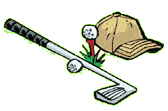GOLF ACTIVITY CARD

Parts of the Body Worked

Abs

Arms

Chest & Back

Knees & Ankles

Lower Back

Wrist & Forearm

Shoulder & Neck
Just what does it take to play golf?
Gear Up
Don’t worry about buying an entire set of golf clubs right away. If you’re just starting out, all you really need are the 5, 6, or 7 irons, a driver, and a putter. You’ll use a driver off of the tee for long distance shots, followed up by your irons, which give more control for shorter shots. And don’t forget your putter—the putter is used on the green.
Next on your list should be golf balls and tees. Tees look like a round peg with a flat top, and are used to raise the ball off of the ground so you can get your club under it better. Put the tee into the ground and sit your golf ball on top of it. Make sure you have plenty of tees on hand—they sometimes break when you hit the ball. Don’t get overwhelmed by the number of golf balls there are to choose from! You don’t have to use an expensive ball because a lot of them will probably end up in the woods or water anyway.
Also, don’t forget that some courses have a dress code. This means that they can ask you to wear certain types of clothing like shirts with collars and shorts or pants without holes in them! As a rule of thumb, keep your clothing simple. Dress in comfortable, loose fitting shirts, pants, or shorts. Sneakers are fine for beginners. And don’t forget a hat and sunscreen! On those hot, sunny days, it’s important to protect yourself from the sun.
Once you’ve got all of your gear, hit the links and have some fun!
Play it Safe
It’s important to warm-up and stretch before you step onto your local golf course. Before swinging, make sure that no one is standing too close—it’s a good rule of thumb to stand at least four club lengths away from the person swinging the club. Don’t play until the group in front of you is out of the way. Stand still and stay quiet while others are in play. If your ball lands in the rough of the course (in high grass, brush, or trees), watch out for creepy, crawly animals and poisonous plants.
Check the weather forecast before going out onto the course. The general rule for avoiding storms is: If you can see lightning, flee it, if you can hear thunder, clear it. Get away from small metal vehicles like golf carts, and put your clubs away. Stay away from trees because they attract lightning, and avoid small on-course shelters—they are made to protect you from rain showers and provide shade.
Whether you’re walking the course or riding in a cart, don’t forget your water bottle. It’s important to drink plenty of water before, during, and after your round. Need a rest? Sit down in a shady area, or under a tree—put a cold towel around your neck to keep you cool.
How to Play
Golf is played on a course with either nine or 18 different holes—a complete game of golf is called a round. It’s important to know the basics of the game and how to use (and choose) your clubs. You may want to take a few lessons from the pro at your local golf course, or rent an instructional video to learn more about the proper swing, grip, and stance.
Check out these tips to get you swingin’ in the right direction.
The Clubs. If your clubs are too long or too short, you’re likely to have problems. To find the right size clubs for you, try swinging with a few different lengths. A good rule of thumb is to choose clubs that are about as long as the distance from your belly button to the floor. You don’t need to decide right away—lots of courses and driving ranges have sample clubs that you can practice with until you find the perfect fit!
The Grip. Need a lesson on how to grip your clubs?
The Stance. Wanna’ see just how to get your perfect stance?
The Swing. The key to the swing is to keep your eyes on the ball. Focus on the ball and keep your head down (and still) when you swing. Your eyes should stay on the ball through your entire swing.
Jack Nicklaus, one of the best players in golf, learned one basic thing from his father—hit the ball hard, and not worry about where it goes—you can always fix that later. By trying to hit the ball far, you’ll naturally try to make the biggest swing with your arms that you can. Swing them back as far as you can—getting your hands behind your head, and follow through as far as you can. You’ll feel your body turn and you’ll notice that while swinging back, your weight will shift to your right foot, and then to your left as you swing through the ball.
Tee it up. If you’re a beginner, hit the ball off of a tee every time—it’s much easier to get under the ball. Put the tee into the ground at different heights to see where you like it best. If you’re a more experienced player, only use a tee when using your drivers. Experiment with your irons once you’re in the fairway to get the ball onto the green. Just remember that the iron you choose depends on how far (and high) you need to hit the ball. Use a 3 iron for long shots to the hole—a 9 iron can be used for those shorter shots.
Ology
Did you know that the dimples on a golf ball make it travel farther? It has to do with air flow. As air flows around a ball without dimples, it breaks away from the surface of the ball forming a pocket of swirling currents behind it—like the wake behind a speedboat. This creates a “drag” on the ball, slowing it down. Dimpled golf balls can easily sail two hundred yards from the tee, while a smooth one (with no dimples) would only go about fifty yards! Golfers discovered this about a hundred years ago, when they noticed their old golf balls, covered with scratches and nicks, sailed farther down the fairway than shiny new ones.
Fun Facts
There are 336 dimples on a regulation golf ball.
When walking on the moon, astronaut Alan Sheppard hit a golf ball that went 2,400 feet, nearly one-half a mile.
In 1997, at the age of 21, Tiger Woods became the youngest player ever to win the Masters (by the largest margin in a major championship in this century).
Related Links
- Page last reviewed: May 9, 2015
- Page last updated: May 9, 2015
- Content source:



 ShareCompartir
ShareCompartir